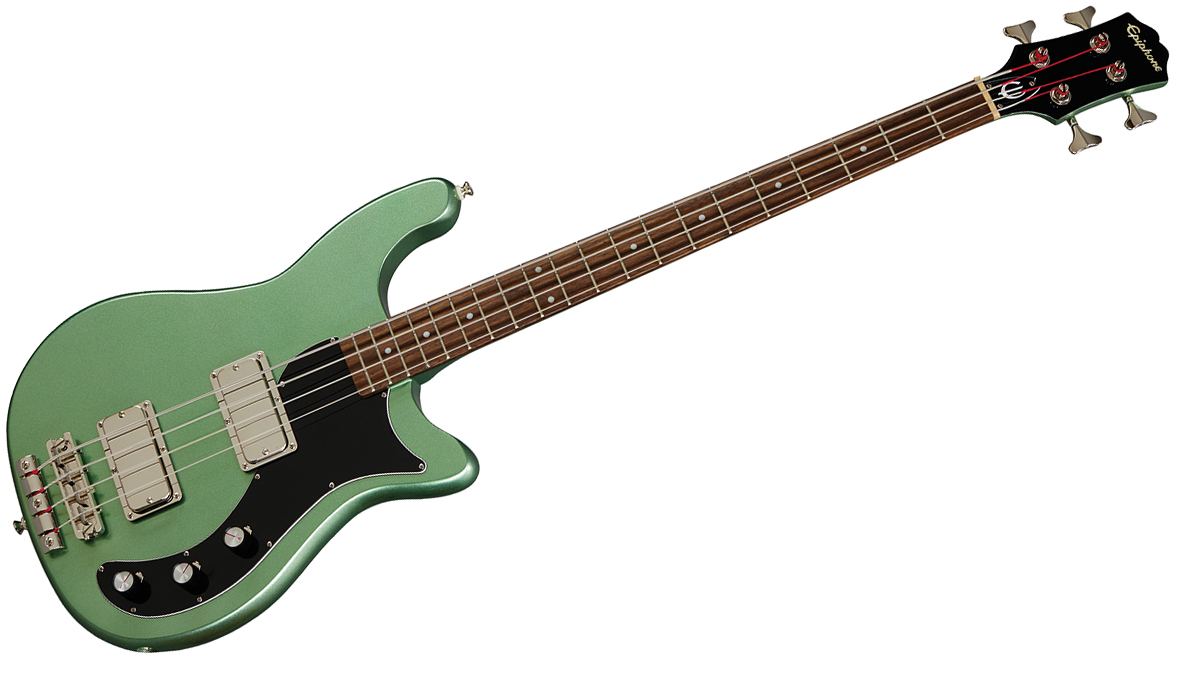Guitar World Verdict
A winner, especially at this price, the Epiphone Embassy is a lovely vintage-inspired bass with a fuss-free setup and an easy charm.
Pros
- +
Effortlessly playable.
- +
Excellent value.
- +
Nice finish options.
Cons
- -
Tones are a tad pedestrian.
You can trust Guitar World
Nostalgia is as prevalent in bass world these days as it is in the rest of the MI industry, with players and luthiers alike all chasing the cool factor of products from the '60s and '70s, when life was simpler, and no-one ever dreamed of needing more than four strings on a bass guitar.
At the same time, of course, bass technology in almost every single application was comparatively unsophisticated, and instruments were prone to underperforming back then unless they were painfully expensive. Nowadays, modern players won’t stand for any of that, all of which is a long-winded way of saying that here’s another vintage-style bass that has been beefed up to cope with the demands of the 21st century.
Epiphone, like you didn’t know already, is the affordable arm of Gibson, just as Squier is the equivalent division over at Fender. Many of us grew up with one or other of these cheap bass variants, in which case you may recall that product quality in both cases varied dramatically back then.
In the era of CNC routing, and hyper-efficient quality control, you’re unlikely to pick up a true dog of a bass even at this low cost: However, anyone who owned the original or later instrument will spot some huge differences in this new reissue. Let’s check them off.
Build Quality
In body shape at least, this new Embassy is a replica of the original 1963-69 instrument.
That bass’s slightly ungainly four-in-a-row headstock was replaced by a smoother, beaky effort in the Japanese reissue from the '80s, and again from 2004 to 2008; it now comes with a two-by-two headstock which, it must be said, serves the vintage look admirably.

Talking of the 2000s reissue, that bass came with long horns, presumably in an effort to fix the headstock dive; those have quite rightly been banished, leaving us with a friendly-looking bass that oozes Sixties-ness.
All the latest guitar news, interviews, lessons, reviews, deals and more, direct to your inbox!
You can gaze at the finish, with its slight sparkle, for hours. It looks great, then. You’ll need to be of vintage mindset to enjoy the new Embassy to the full, with its asymmetrical double cutaway, the fake bone nut, the pearloid inlay dots, and so on.
The volume, pickup blend, and tone controls are very much of their time, with metal inserts sticking out underneath them – bassists of a certain age will recall these curious appendages. The nickel hardware hits ‘peak 1963’ with the bridge, which Epiphone have proudly labelled a “Historic Bass Tune-O-Matic, with Historic Claw Tailpiece”. It’s a likeable, efficient chunk of metal with ample room for adjustment.
Sounds And Playability
Plug in, and you’ll be in easy, familiar territory—the glass of warm milk of bass, if you like. The 41mm nut width is finger-friendly, and the significant mass of the neck is rendered simple rather than strenuous by the finish, which hits the midpoint between sticky and slippery.

The two ProBucker pickups don’t sound drastically different – wasn’t it always that way back then? – so you need to go to the extremes of the tone range to find a really useable spectrum.
I particularly enjoyed rolling on the tone to max, isolating the rear pickup and plucking very close to the bridge, for a taut, punchy, almost Eighties sound. Otherwise, this bass is happiest with the expected muffled low end, leavened by a touch of sharpness.
There’s neither a thunderous bottom end nor a glassy top, and you’d be mad to expect either. The Embassy is very playable in a stately manner. You wouldn’t choose it if you were intending to double-thumb sixteenths at the 18th fret at 200bpm, obviously, but if you’re interested in notes that count, and that have gravitas, look no further.
Conclusion
At this cost, you have no reason whatsoever not to investigate the new, or rather new old, Embassy: It sounds great and plays very nicely indeed. Sure, it’s no souped-up superbass, but it’s a totally approachable instrument that will be a friend for life. Seek one out by all means.
Specs
- PRICE: $399 / £349
- MADE IN: Korea
- BODY: Layered maple with single-ply cream binding, Sparkling Burgundy and Faded Pelham Blue finishes available
- NECK: Mahogany, 34” scale
- FINGERBOARD: Indian Laurel, 20 frets
- PICKUPS: JCB-1 low-impedance humbucker
- CONTROLS: Volume, tone, three-way rotary selector
- HARDWARE: Die-cast tuners, adjustable bridge and tailpiece
- CASE/GIG-BAG INCLUDED: No
- LEFT-HANDED OPTION: No
- CONTACT: Epiphone
Bass Player is the world’s most comprehensive, trusted and insightful bass publication for passionate bassists and active musicians of all ages. Whatever your ability, BP has the interviews, reviews and lessons that will make you a better bass player. We go behind the scenes with bass manufacturers, ask a stellar crew of bass players for their advice, and bring you insights into pretty much every style of bass playing that exists, from reggae to jazz to metal and beyond. The gear we review ranges from the affordable to the upmarket and we maximise the opportunity to evolve our playing with the best teachers on the planet.


